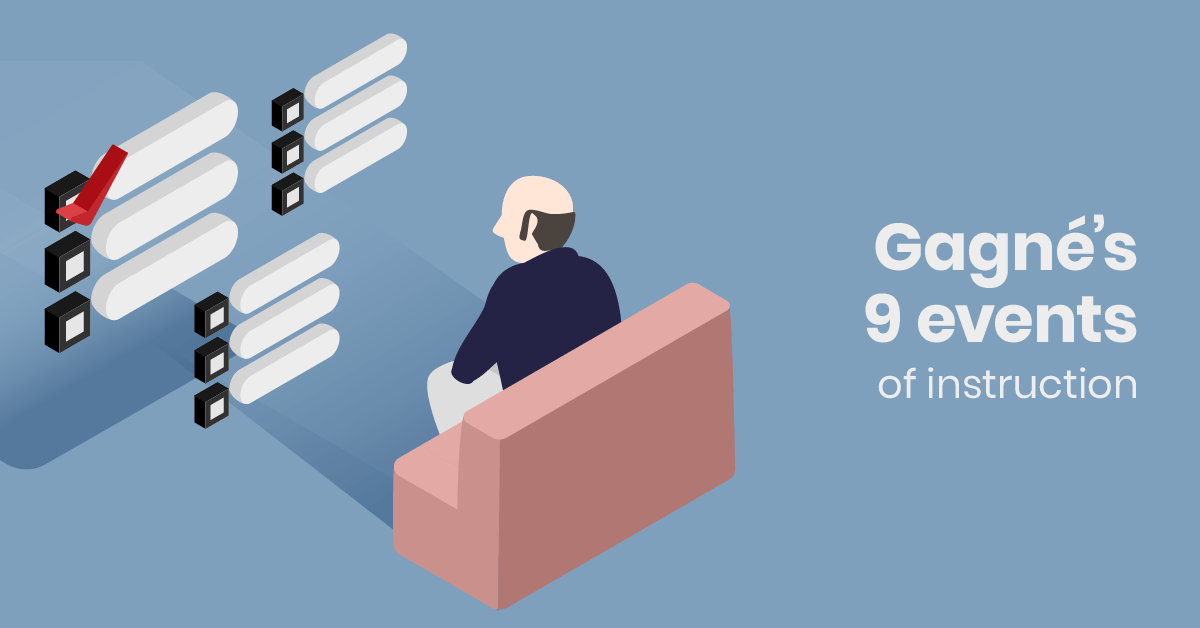With great results.
Here, we look at the theory behind each of those 9 events of instruction. And show how this step-by-step approach can help managers, trainers, facilitators, and instructional designers (and their audience) in the very real and very current world of corporate training.
Throughout his nine events of instruction, Gagne uses theatrical metaphors to reinforce his instructional design-focused learning model. So, before we raise the curtain on the main event, let’s first take a quick peek backstage.
Setting the scene
Easing his audience gently into his nine events of instruction, Gagne’s first step is to look at the context and conditions that might impact the learning journey. Gagne called them his “conditions of learning”. So, what does Gagne mean by “conditions of learning”? To help clarify, he separates them into two types — internal and external.
Internal conditions, Gagne says, refer to the general knowledge we’ve already acquired and placed in our memory. This so-called “semantic memory” covers everything from our prior knowledge of objects, people and words, to facts, ideas and concepts. What this means is that what we already know, or think we know, has a strong bearing on how we absorb or interpret additional learning.
So does the immediate and physical learning environment, says Gagne.
Whether it’s the tone of voice of the instructor, a claustrophobic or stuffy meeting space, or a laptop with poor wifi, external conditions all have a bearing on how we connect (or not) with the content of a training or learning program.
Right. That’s the background. The stage is set. But, before we open the curtain on the next nine acts, it’s time for a dramatic pause.
The prologue
While it’s tempting to leap ahead, straight into Gagne’s hierarchy of learning, there’s an important step that precedes his nine events. That’s the process of setting broad categories of outcomes.
Gagne separates his outcomes into five distinct categories: intellectual skills, cognitive strategies, verbal information, attitudes, and motor skills. These categories each relate to learned capabilities which Gagne observes and views as human performances.
So, with everything in place, it’s time to raise the curtain and learn more about the nine events that will support those outcomes.
The big reveal
Putting Gagne’s learning model theory into action, here’s where Gagne’s nine events of instruction come in.
Designed to be followed in sequence, Gagne’s nine events of instruction cover all of the different elements required for effective learning. Here, we’ll combine the theory behind each event, with some practical examples of how to put that theory into action.
1. Gaining attention
Distractions are the enemy of learning. Use a strong and noticeable auditory, visual or verbal cue to signal the start of the training session, grab your learners’ attention and shift focus from what’s going on around them.
How:
- Reveal a fun fact
- Show a video or play a piece of music
- Ask a quirky or unexpected question
- Share questions sent in by students that will be answered during the session
2. Informing learners of the objective
Place a value on your training and drive motivation by making it clear what your learners will achieve: personally, professionally, and as part of a wider team.
How:
- Show relevance of course content to a particular career or profession
- Use factual content to illustrate impact (for example, learning about “X”, the organization will be able to do “Y” and not have to make “Z” redundancies)
- Ask learners what they want/expect to achieve and then work together to create success criteria that are owned by all
- After completing each task, refer back to how this will benefit them and the organization
- Include course objectives on slides and activity prompts
3. Stimulating recall of prior learning
Learning doesn’t take place in a vacuum. Draw in skills or knowledge acquired by attendees prior to the session and link these up with relevant aspects of the course. Showing how these separate nuggets of knowledge can be combined to deliver stronger and more powerful results, adds meaning and increases motivation.
How:
- Refer back to topics covered earlier in the session and relate these to current tasks
- Create activities designed around applying previous knowledge or skill to new tasks
- Ask students to share examples of information gathered before the course and how it relates to the course at hand
4. Presenting the content
People learn in different ways. Similarly, each learning outcome suits different delivery methods. Present the content of your training module in a way that acknowledges both of these factors.
How:
- Match learning outcomes with the right format (for example, if you’re delivering first aid training, use video to highlight the motor skills required to perform the procedures and then a PowerPoint or infographic to summarize the theory behind the practice)
- Deliver the same message or task in a variety of formats
- Provide an online learning platform students can access in their own time to refresh, recap, or review course content
5. Providing learning guidance
For learning to be effective, it has to have meaning above and beyond words on a page or bullet points in a presentation. Bringing learning to life by illustrating your message in different ways supports better recall and retention of information.
How:
- Cite real-life examples of how your learning has been previously applied (case studies are a great way of doing this)
- Share non-examples to illustrate how not to use the learning
- Use analogies and metaphors to draw comparisons between new concepts and familiar, commonly held knowledge
- Tell a (business) story. Following a narrative structure is a good way to engage your audience
- Provide visual representations of abstract concepts to stimulate and aid recall
- Use mnemonic devices such as acronyms, acrostics, notes of organization, or names of expression to reinforce learning ideas
6. Eliciting performance
At this point, it’s time for your team to take the stage and put what they’ve learned into practice. Demonstrating their newly acquired knowledge through performance helps cement knowledge. And, your role (or the role of course leader) is to provide opportunities for them to do so.
How:
- Invite students to model learning strategies using role play
- Devise activities that reinforce the adoption of new skills (collaborative, group exercises centered around an open-ended assignment, deep-learning question are a good way of doing this)
- Use interactive assessments, quizzes, and tests that focus on comprehension and application of learning
7. Providing feedback
Remember the outcomes you set right at the beginning? Gathering and sharing feedback is an important part of keeping learning on track and closely tied to those outcomes. Make it personal and, most importantly, make it ongoing and timely — don’t leave feedback to the end. Identify gaps in knowledge early on, so they can be addressed.
How:
- Encourage learners by marking moments of success with positive feedback
- Provide detailed and specific evaluations of skills or knowledge acquired
- Ask students to critique their own work or performance
- Look forward by identifying next steps and areas of improvement
- Facilitate group feedback by giving individuals the chance to view and discuss each other’s work and compare it to their own
8. Assessing performance
The penultimate event in Gagne’s nine events of instruction concentrates on measuring each individual’s attainment and retention of knowledge. Have goals and outcomes been achieved? If not, where is more support required?
How:
- Carry out assessments at the beginning and end of each learning module to measure progress
- Use one standard set of rules and scores (a rubric) to keep evaluation consistent, transparent, and easy to track
- Make sure all learners are aware of the assessment criteria
- Use multiple assessments (with different types and formats) to evaluate the same area of learning. This way, you’ll produce a more robust and reliable set of results.
9. Enhancing retention and transfer
Practice makes perfect, the saying goes. The final act in Gagne’s nine events echoes this, promoting rehearsals as a means of cementing long-term knowledge and developing skills that transfer outside the learning environment.
How:
- Link different learning modules together to demonstrate how information can be transferred to different situations
- Give learners the chance to repeatedly practice new skills or techniques to support long-term retention
- Organize “rehearsals” where students can try out new processes and skills learned and follow these with debriefing sessions to review performance
- Stagger or space out practice sessions over a period of time to aid long-term recall

The epilogue
Structured, systematic, and step-by-step, Gagne’s nine events of instruction give instructional designers or course creators a clear, coherent yet adaptable approach to follow. But, it does have its limitations.
Perhaps it’s too structured? There’s certainly not much scope for creativity or independent experimentation. And for some instructional designers, it could also be considered a little dull. Only you can judge when and whether it’s right for you.
If you’ve got a course that’s heavily focused on critical thinking or designed to encourage problem-solving, for example, it may not be the most appropriate learning model. But if you need to train everyone in your team on a new piece of software, tool, or equipment, for example, a highly organized checklist like Gagne’s 9 events could be just right.
So, before we let the curtain fall, remember you’re the director. This is your show. You don’t have to use Gagne’s approach in isolation or exactly as prescribed. Tailor the events to suit different learning topics. Or, combine it with other training models. You’ve got the script. How you use it is up to you.



